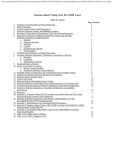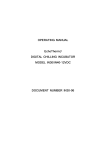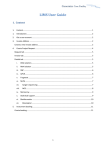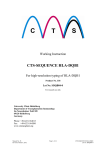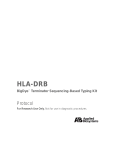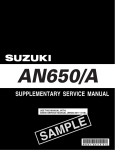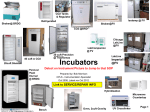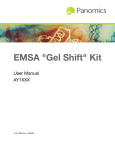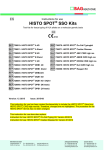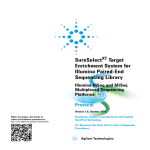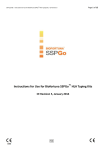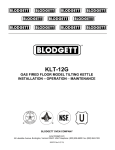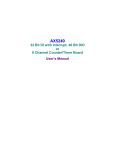Download Genotyping of the HLA-DQB1 Gene
Transcript
Persons using assistive technology may not be able to fully access information in this file. For assistance, e-mail [email protected]. Include the Web site and filename in your message. Genotyping of the HLA-DQB1 Gene Table of Contents Page number 1. 2. 3. 4. 5. 6. 7. 8. 9. 10. 11. 12. 13. 14. 15. 16. 17. 18. 19. 20. 21. 22. 23. 23. Summary of Test Principle and Clinical Relevance Safety Precautions Computerization; Data System Management Specimen collection, Storage, and Handling Procedures Procedures for Microscopic Examination; Criteria for Specimen Rejection Preparation of Reagents, Calibrators (standards), Controls, and All Other Materials; Equipment and Instrumentation a. Reagents b. Reagent preparation c. Standards d. Controls e. Equipment and materials f. Instrumentation Calibration and Calibration verification Procedures Procedure Operating Instructions; Calculations; Interpretation of Results a. Procedure b. Calculations c. Interpretation of results Reportable Range of Results Quality Control (QC) Procedures a Quality Control Principles b. Preparation of Quality Control Materials Remedial Action if Calibration or QC Systems fail to meet acceptable criteria Limitation of Method; Interfering Substances and Conditions Reference Ranges (Normal Values ) Critical Call Results Specimen Storage and Handling During Testing Alternate Methods for Performing Test or Storing Specimens if Test System Fails Test Result Reporting System; Protocol for Reporting Critical Calls (if applicable) Transfer or Referral of Specimens; Procedures for Specimen Accountability and Tracking References Appendix A: Puregene Method for DNA Isolation from Whole Blood for PCR using the Puregene Genomic DNA Isolation Kit. Appendix B: Human Identification with short Tandem Repeat Loci using the AmpFlSTR Green I PCR Amplification Kit. Appendix C: Identification of the Amelogenin and TH01 markers Appendix D: HLA-DQB1 Sequence-Based Genotyping Method Appendix D: PCR-based differentiation of HLA-DQB1 Alleles using the DYNAL RELITM SSO HLA-DQB1 test 2 3 3 4 4 4 4 5 5 5 5 7 7 7 7 7 7 8 9 9 9 9 10 11 11 11 11 12 12 13 14 18 20 23 29 1. Summary of Test Principle and Clinical Relevance Type 1 diabetes mellitus is a chronic autoimmune disease that involves a T cell-mediated destruction of the pancreatic beta cells, the body’s sole source for insulin1. This disorder is the most common chronic disease among children and young adults2. Complications include kidney failure, blindness, amputations, nerve damage as well as an increased risk for heart attacks and strokes3. Type 1 diabetes has been shown to involve a genetic component and an environmental component4. Thus, an environmental trigger in a susceptible genetic background results in type 1 diabetes development. This genetic component is the earliest predictor of type 1 diabetes and may eventually allow prediction in the prenatal phase leading to early prevention and/or treatment. The genes that are known to play a role in the genetic susceptibility include those in the Human Leukocyte Antigen (HLA) complex on chromosome 6p21, and the insulin gene on chromosome 11p155. The role of the HLA region in type 1 diabetes was discovered in the 1970s by both association studies and affect-sib-pair studies6-8. The DR3 and DR4 haplotypes, which consist of specific combinations of the class II genes DQA1, DQB1 and DRB1, have been implicated in disease susceptibility, and the DR2 haplotype has been associated with disease protection as determined by serotyping 9-12. These class II HLA genes are highly polymorphic and molecular genetic analysis has identified certain alleles with protection or susceptibility to type 1 diabetes 12-26. The assay described below involves genotyping the HLA DQB1 gene. Previous studies have found that DQB1 alleles *0201and *0302 are predisposing for type 1 diabetes and the DQB1 allele *0602 has a protective effect12,27-29. This study will allow confirmation of these results as well as allow the minor genetic risk factors to be identified by controlling for the major genetic risk. The PCR-based (Polymerase Chain Reaction-based) reverse line blot assay, using ProfiBlot II T, is a simple and fast genotyping method for HLA typing. The assay is based on three major processes: PCR amplification of an approximately 300 base pair region of the polymorphic second exon of the DQB1 gene, hybridization of the amplified product to an array of immobilized sequence-specific oligonucleotide probes, and detection of the probe-bound amplified product by color formation. In the first process, double-stranded DNA is denatured to expose the target sequence to biotinylated primers. The primers anneal to the target sequence and are extended to produce biotinylated DNA sequences termed amplicons. Amplified biotin-labeled amplicons are chemically denatured in the second process during which they hybridize to sequence-specific probes. Stringent hybridization conditions ensure the specificity of the reactions. During the third process, the hybrids are treated to produce a colored complex that can be visually detected in the form of lines on a typing strip. The HLA-DQB1 genotype is assigned by reading the pattern of the colored lines that appear on the strips, either by manual comparison or by using a computer program. This assay has the potential to identify all of the DQB1 alleles, since in most instances, new alleles appear as unique probe hybridization patterns and not as blanks. To increase our allele resolution capacity, a new sequenced-based genotying method has been developed for HLADQB1. The method is comprised of three assays, two of which are used only for the resoltion of specific ambiguities: the sequencing assay of exon2, the auxiliary sequence-specific sequencing (SSPS) assay, and the auxiliary 5’ nuclease assay for exon3. The sequencing assay consists of PCR amplification with PCR primers sapning some intronic and exon sequences and carrying M13 taggs on their 5’ ends and of sequencing of these amplicons with M13 sequencing primers. The acquired sequence is detected by the ABI PRIM 3100 Genetic Analyzer and analyzed by the Sequence Analysis program. The final step in the analysis procedure is to perform the allele assignment using MatchTools Software and MTNavigator Software. These programs work together to assign alleles and to allow manual review or editing of the sequence data. In some cases, it is not possible to distinguish among possible pairs of heterozygous genotypes, unless the two chromosomes are examined separately. In such instances, the already available PCR products are sequenced using sequence-specific sequencing (SSPS) primers specific to only one chromosom of a pair. By analyzing this sequence, it is possible to identify which one of the two pairs of alleles is present. Since allele pairs HLA-DQB1 0201 and 0202, HLADQB1 03011 and 0309, and HLA-DQB1 06011 and 06012 are identical in exon2, it is necessary to perform the auxiliary 5’ nuclease assay in exon3 to determine the exact genotype. This assay utilizes the ABI PRISM 7700 Sequence Detection System and TaqMan® chemisty, which employes two probes tagged with unique fluorescent reporter molecules. The two probes, one complementary to one member of the allele pair and the other to the other (eg. 0201/0202) will bind only to an individual’s DNA when there is an exact match of sequence. During the PCR amplification process, the Taq Polymerase enzyme will encounter the bound probe and displace and destroy the probe. 2 This process releases the bound fluorescent molecule that is then detectable by the ABI PRISM® 7700 Sequence Detection System. 2. Safety Precautions Standard safety precautions should be observed including wearing safety glasses, lab coats and gloves during the preparation of blood specimens. Follow Universal Precautions when handling all blood and blood products. Vaccination for hepatitis B is strongly encouraged. Laboratory items exposed to blood or blood products should be disposed of or decontaminated in compliance with guidelines from Office of Health and the Safety, CDC. The following chemicals are used in this genotyping process: Ethidium Bromide (EtBr) Ethidium Bromide is used to visualize double-stranded DNA that has been separated by size on an agarose/acrylamide gel matrix. The EtBr intercolates into double-stranded DNA, and will fluoresce when visualized on a UV transilluminator. EtBr is a potential carcinogen, and extreme caution should be taken when working with this chemical. Observe all safety precautions such as wearing a lab coat, fresh gloves, and protective eye-wear. HiDi Formamide HiDi Formamide is used in small amounts within the laboratory to resuspend DNA for automated sequencing (also found in Template Suppression Reagent). Formamide is a teratogen which can affect any fetal development. Always use extreme caution while handling with formamide, and observe all safety precautions such as wearing a lab coat, fresh gloves, and protective eye-wear. *NOTE: women who are or plan to become pregnant should not work with formamide due to its adverse effects on fetal development. Performance Optimized Polymer 4 and 6 (POP 4)/(POP 6) These polymers are used within the automated sequencers and act as media through which the DNA samples are transported through capillaries. Both of these polymers contain high amounts of urea, which is a potential mutagen and has been shown to have reproductive and tumorigenic effects. Observe all safety precautions such as wearing a lab coat, fresh gloves, and protective eye-wear. Acrylamide Acrylamide is used for large sequencing gels used on the PE Biosystems 377 DNA Sequencer. Acrylamide is a poison, neurotoxin, irritant, carcinogen, and possible teratogen. The effects of this chemical are cumulative, so always use it with the upmost caution. Observe all safety precautions such as wearing a lab coat, fresh gloves, and protective eye-wear. Tetramethylbenzidine (TMB) and Substrate B TMB and Substrate B are Dynal RELITM reagents. They are used to form a color complex in genotyping. These reagents are teratogens and possible mutagens. Always use extreme caution while in contact with these agents, and observe all safety precautions such as wearing a lab coat, fresh gloves, and protective eyewear. *NOTE: women who are or plan to become pregnant should not work with formamide due to its adverse effects on fetal development. 3. Computerization; Data System Management Integrity of specimen data generated by this method is maintained by proofreading all transcribed data by the analyst. All data is copied to a CD-R for transfer to a Microsoft Access database created to store all raw data generated in the GoKinD study. Only authorized personnel from the Molecular Biology Branch (as determined by the supervisor) have access to this database. Analyzed genotype results are recorded by the analyst in a Microsoft Access database located on CDC’s LAN, and only authorized personnel from the Molecular Biology Branch (as determined by the supervisor) have access to the data. 3 5. 4. Specimen Collection, Storage, and Handling Procedures; Criteria for Specimen Rejection a. Specimen collection: Whole blood obtained with EDTA as an anticoagulant may be used. All 10 ml of the venous blood collected will be processed for DNA. b. Specimen storage: Blood samples which have been processed by the Puregene method through the cell lysis step (see Appendix A) can be stored at room temperature for up to eighteen months. Extracted DNA can also be stored at -20˚C indefinitely until assayed. c. Freeze-Thaw effect: Repeated freeze-thaws may cause slight fragmentation of DNA. However, the size DNA targeted for amplification is very small (<400bp) and there is no documented deleterious effect of freeze-thaw on this test. Procedures For Microscopic Examination; Criteria for Rejection of Inadequately prepared slides Not applicable for this procedure. 6. Preparation of Reagents, Calibrators (standards), Controls, and All Other Materials a. Reagents The Puregene DNA Isolation Kit (Gentra Systems) contains the Red Blood Cell Lysis Solution (RBC Lysis Solution), Cell Lysis Solution, RNase Solution, Proteins Precipitation Solution, and DNA Hybridization Solution. All reagents except the RNase solution are stable at room temperature until the expiration date indicated by the manufacturer. The RNase Solution is stable at 4ΕC until the expiration date. The AmpFlSTR Green I PCR Amplification Kit is stored at 4˚C until the manufacture’s expiration date. Check the expiration date before each use and discard the kit after that date. The HiDi Formamide is aliquoted into separate tubes and stored at -20˚C. The Dynal RELITM SSO HLA-DQB1 Typing Kit contains Control DNA, HLA-DQB1 Master Mix, 6.0 mM MgCl2 Solution, and the HLA-DQB1 Typing Strips, all of which must be stored at 2-8˚C. These reagents are stable until the expiration date indicated by the manufacturer. The Dye Terminator Cycle Sequencing Ready Reaction Kit, which contains the reagents for the control reaction for cycle sequencing and sequencing, may be stored at -20˚C until the manufacture’s specified expiration date. Discard after expiration date. The Terminator Ready Reaction Mix is light-sensitive and should be stored without exposure to light. TaqMan Universal PCR Mastermix. This reagent should be stored at 4°C and is stable until the expiration date indicated by the manufacturer. The Dynal RELITM SSO Strip Detection Reagent Kit includes the following reagents: a. Denaturation Solution which should be stored at 2-25˚C. This reagent is stable until the expiration date indicated. b. SSPE Concentrate, SDS Concentrate, Streptavidin-HRP Conjugate, Substrate A, Substrate B and Citrate Concentrate, which should be stored at 2-8˚C. These reagents are stable until the expiration date indicated. Substrate A and B or Working Substrate (mixture of Substrate A and B) should not be exposed to metals, oxidizing agents or direct light. Working substrate is stable for three hours when protected from light. c. Working Hybridization Buffer Working Wash Buffer and Working Citrate Buffer (See Appendix C “Reagent Preparation”), which should be stored at room temperature and are stable for 3 months. 4 b. Preparation of Reagents See Appendix A, B, C and D. c. Standards This is a qualitative assay and calibration standards are not used. See Part 7. d. Controls For the AmpFlSTR Green I Human Identification Assay a positive control of a previously genotyped DNA, and a negative “no template control” control is tested with each PCR amplification run. With each identification run the control DNA and a Green I Allelic Ladder is always tested. Identification of Amelogenin and THO1 Markers An in house control DNA of a known genotype and an in house allelic ladder are prepared at a set concentration. The in house control DNA is stored at -20C in a “clean” laboratory and the in house allelic ladder is stored at 4C in a “dirty” laboratory where amplified DNA is in use. For the TaqMan assay on an ABI PRISM 7700 for genotyping in exon 3, a pair of in-house control DNA samples of appropriate homozygous genotypes are used as positive controls: 0201/0201 and 0202/0202, 03011/03011 and 0309/0309, and 06011/06011 and 06013/06013, No template reactions serve as negative controls. For HLA-DQB1 Sequence-based genotyping an in-house DNA sample of known genotype is used as a positive control. The control DNA is stored at –20°C in a “clean” laboratory in which no amplified DNA is present. Single stranded DNA, pGEM, which is supplied with Dye Terminator Cycle Sequencing Ready Reaction Kits (Applied Biosystems), is used as a control for sequencing chemistries. For the ProfiBlot Reverse Line Assay two controls, one positive and one negative, are tested with each PCR amplification. The Dynal RELITM Control DNA is used as a positive control and distilled water is used as “no template” control. The PCR product of the Control DNA serves as a positive control in the subsequent detection assay, producing a predetermined typing pattern (positive signal for lines 1, 2, 5, 6, 12, 18, 20, 24 and C). In addition, each HLA-DQB1 Typing Strip contains an internal control (the “C” line), which detects all HLADQB1 alleles. The intensity of the “C” line, or its presence or absence, determines the validity of the assay. e. Equipment and Materials AmpFlSTR Green I PCR Amplification Kit, (Applied Biosystems, Foster City, CA) AmpFlSTR Green I PCR Amplification Kit User’s Manual, (Applied Biosystems, Foster City, CA) Performance Optimized Polymer 4 (POP-4), (Applied Biosystems, Foster City, CA) 3100 Performance Optimized Polymer 6 (POP-6) (Applied Biosystems) Puregene DNA Isolation Ki, (Gentra Systems, Minneapolis, MN) Glycogen (Gentra Systems, Minneapolis, MN) Dye Terminator Cycle Sequencing Ready Reaction Kit (Applied Biosystems, Foster City, CA) Dynal RELITM Typing Kit and SSO Strip Detection Reagent Kit (Dynal UK Inc., Wirral, UK) Qiagen Sigma centrifuge (Qiagen Inc., Chatsworth, CA) Stratalinker UV Crosslinker 2400 (Stratagene, La Jolla, CA) GeneAmp PCR System 9700 thermal cycler (Applied Biosystems, Foster City, CA) ABI PRISM 310 Genetic Analyzer, (Applied Biosystems, Foster City, CA) ABI PRISM 3100 Genetic Analyzer(Applied Biosystems) Sequencing Capillaries (47cm x 50um) (Applied Biosystems, Foster City, CA) ABI PRISM 377 DNA sequencer (Applied Biosystems, Foster City, CA) Computer and software for analysis with GeneScan and Genotyper Software, (Applied Biosystems, Power Pak 300 Power Supply (BioRad, Hercules, CA) 5 Computer software for analysis with Sequencing Analysis, Match Tools, MTNavigator, GeneScan and Genotyper (Applied Biosystems) Electrophoresis unit with power supply (any vendor) Gel documentation system (any vendor) Boekel Orbital Rocker (Boekel Scientific Inc., Feasterville, PA) ProfiBlot II T (TECAN U.S. Inc., NC) Vortex Genie, Daigger, (Lincolnshire, IL) IEC Multi Centrifuge with Double Deep Microplate Rotor (Forma Scientific Inc., Marietta, OH) Savant Vacuum centrifuge (Forma Scientific Inc., Marietta, OH) Heating block (any vendor) Incubator (any vendor) Water bath (any vendor) Balance (any vendor) PipetAid Drummond (Daigger, Lincolnshire, IL) Finnpette Biocontrol Pipettor with Multi-channel module (Lab Systems/Marsh Biomedical Products Inc.) Dispensette III volume dispenser for reagents (Daigger, Lincolnshire, IL) Micropipettors (any vendor) Micropipettes with filter (aerosol) tips (any vendor) Sterile, individually wrapped, transfer pipettes (any vendor) 50 ml Falcon centifuge tubes (any vendor) MicroAmp 8-Strip Reaction Tubes 0.2 m, (Applied Biosystems, Foster City, CA) MicroAmp Caps (8 caps/strip), (Applied Biosystems, Foster City, CA) MicroAmp Reaction tubes with caps, tube trays and bases, (Applied Biosystems, Foster City, CA) MicroAmp 96-Well Tray/Retainer, (Applied Biosystems, Foster City, CA) MicroAmp 96-well reaction plate (Applied Biosystems, Foster City, CA) 96-well plate septa (Applied Biosystems, Foster City, CA) Microtiter plate Racks for 50 ml centrifuge tubes (any vendor) 0.5 ml Genetic Analyzer sample tubes and septa, (Applied Biosystems, Foster City, CA) Deionized water Ultra-pure agarose (Gibco/BRL, Rockville, MD) GeneScan-350[ROX] Internal Lane Size Standard, PE Biosystems, Foster City, CA Hi Di formamide, (Applied Biosystems, Foster City, CA) 10 X TBE Buffer (any vendor) 10x Genetic Analyzer Buffer with EDTA, (Applied Biosystems, Foster City, CA) 10X TBE (Trizma Base, Boric Acid, EDTA) for Sequencing 1xTE (10mM Tris-HCl, 0.1mM EDTA, pH 8.0) (any vendor) DNA ladder (any vendor) Gel loading dye (any vendor) Ethidium Bromide (any vendor) 70% ethanol (any vendor) 100% isopropanol (any vendor) Glass flasks (any vendor) Nitrile gloves (any vendor) Microwave oven (any vendor) Disposable towels and tissues (any vendor) Disposable bench-top covers (any vendor) f. Instrumentation The GeneAmp PCR System 9700 is an automated thermal cycler with interchangeable sample blocks, used to carry out PCR amplification reactions. Methods, instructions that specify how the instrument should heat or cool samples in a PCR thermal profile, are programmed and stored in the instrument software. The Geneamp PCR System 9700 offers greater speed, oil free operation, lower reaction volumes, and cycle time reproducibility. The ProfiBlot II T is a fully automated system for the complete Western Blot or Reverse Line 6 Blot assays. It has 24 wells for loading strips and automated reagent addition and aspiration. Chemically denatured, single-stranded amplicons are added to the wells which contain nylon membranes with the immobilized, sequence specific oligonucleotide probes. Under stringent conditions the biotin labeled amplicons hybridize with the sequence specific probes. Unbound material is removed with a stringent wash. To produce a color complex, first a streptavadin-horseradish peroxide (SA-HRP) conjugate is added to the wells where it binds to the biotin-labeled amplicon-probe hybrids. Unbound conjugate is then washed off and the bound conjugate is reacted with hydrogen peroxide (H2O2) and tetramethylbenzidine (TMB). The reaction is stopped by several water washes. The color complex then reveals the specific typing patterns of the samples. The ABI PRISM® 7700 Sequence Detection System contains a built-in 96-well thermal cycler. To induce fluorescence during PCR, laser light is distributed to the 96 wells via a multiplexed array of optical fibers. The resulting fluorescent emission returns via the fibers and is directed to a spectrograph with a charge-coupled device (CCD) camera. The Applied Biosystems PRISM 310 and 3100 Genetic Analyzers can be used for both fragment analysis as well as for sequencing applications. All instruments undergo electrophoresis, laser excitation and detection via a chargedcoupled device (CCD) camera which provides simultaneous detection of all four colors from a single sample run. 7. Calibration and Calibration Verification Procedures The GeneAmp 9700 thermal cycler, the ABI PRISM, 310 and 3100 Genetic Analyzers, the ABI PRISM 7700 Sequence Detection System, and the ProfiBlot II T are pre-calibrated by the respective manufacturer and annual preventive maintenance is preformed by the manufacturer’s authorized service representative. This PCR-based Profigenotyping assay is a qualitative test, where the Typing Strips can distinguish 31 different DQB1 allele groups. In most instances, new alleles appear as unique typing probe hybridization patterns. The outcome of the PCR amplification reaction can be either positive, if the amplification yields fragments of 300 base pairs in length, or negative, if the amplification yields fragments of a different size(s), or none at all. If the Control DNA PCR fails to yield the correct typing pattern then the whole test is invalidated and repeated (see section 11). 8. Procedure Operating Instructions; Calculations; Interpretation of Results a. Procedure: See Appendix A, B, C and D for DNA extraction, amplification and detection. b. Calculations This is a qualitative assay and calculation is not used. (See item 7 for details.) c. Interpretation of results AmpFlSTR Green I Human Identification Assay. The AmpFl STR Green I PCR Amplification Kit amplifies the TH01, TPOX and CSF1PO short tandem repeat loci. In addition, the primers included in the AmpFl STR Green I Primer set amplify the Amelogenin locus which can be used for gender determination. The amplification products are run on an ABI PRISM instrument and the collected multicolor fluorescent data is analyzed using GeneScan Analysis Software. The Genotyper Software converts fragment sizes to genotypes which can then be uploaded into a database. HLA-DQB1 Sequence-based Typing (SBT) The HLA-DQB1 SBT is a single-tube reaction that amplifies the entire exon2 region of all allele groups. This step eliminates the need for multiple, group specific PCR reactions characteristic of other sequence-based DQB1 assays. The results obtained are qualitative and are interpreted with the help of MatchTools and MTNavigator softwares. With thses programs, it is possible to assign genotyps and review and edit sequences. Genotypes are entered into the database according to standard HLA nomenclature (for reference see: http://www.anthonynolan.com). In determining ambiguous heterozygous genotypes, sequence specific sequencing primers are used to amplyfy only one of the chromosomes, making it possible to identify the alleles present. The results obtained are qualitative and are interprethed with the help of MatchTools and MTNavigator softwares. With the two programs it is possible to 7 assign genotyped and manually review and edit sequences. Genotypes are entered into the database according to standard HLA nomenclature. For the resolution of alleles that are identical in exon 2 using the ABI PRISM® 7700 Sequence Detection System, data is collected by the instrument and analyzed according to the specifications in the user’s manual. The analysis software of the instrument names samples as A1 for samples homozygous for one allele, A2 for samples homozygous for the other and A1 and A2 for heterozygous samples. The genotypes can be confirmed by examining the Real Time data collected. The data is viewed in the multicomponent view, where emission intensity is plotted over time. Distinct spectral patterns are produced by each of the control reactions: a. spectral pattern of the “no-template controls” will have little or no increase in emission intensity of either one of the reporter dyes (TET and FAM). b. spectral pattern of the homozygous controls should have a significant increase in emission intensity of the reporter dye present on the probe specific to each allele, relative to the “no-template controls”. For example, a sample homozygous for an allele identical in sequence with a probe carrying a TET reporter dye will have a c. Homozygous test samples should have a similar increase in emission intensity of the respective reporter dye, relative to the “no-template controls”. Heterozygous test samples should display a significant increase in emission of both reporter dyes, relative to the “no-template controls”. ProfiBlot II T genotyping assay. The HLA-DQB1 type is assigned by reading the pattern of the positive signals (blue lines) on the HLA-DQB1 Typing Strip to determine which HLA-DQB1 alleles are present in the DNA samples. This can be done by using the Dynal RELITM SSO Pattern Matching Program. Identification of Amelogenin and TH01 Markers This PCR based method amplifies the Amelogenin locus and the TH01 short tandem repeat loci. These markers are used for quality control purposes for samples that are not trios. 9. Reportable Range of Results Not applicable, see item 7 for details. 10. Quality Control (QC) Procedures c.Quality Control Principles The type I diabetes genotyping method described in this protocol has been well established in the Division of Environmental Health and Laboratory Sciences. These methods have proven to be accurate, precise, and reliable. Reliability of all test results should be monitored by routinely using a positive control, the Control DNA supplied with the Typing Kit, and a negative or “no template” (water) control. The AmpFlSTR Green I human identification assay is considered out of control if: 1.The electropherogram for the fragment analysis contains less than 4 or more than 8 peaks. 2.The GeneScan-350 ROX Internal Lane standard does not appear on the electropherogram. 3.The signal is too weak on the electropherogram. If the run is declared “out of control,” the fragment analysis should be repeated. If the run is “out of control” again, the PCR as well as the fragment analysis is invalidated and repeated. The Idenfication of Amelogenin and TH01 Markers assay is considered to be out of control if: 1.The electropherogram for the fragment analysis contains less than 2 or greater than 4 peaks, 2.The GeneScan-350 ROX Internal Lane standard does not show up on the electropherogram, or 3.The signal is too weak on the electropherogram. If the run is declared “out of control,” the fragment analysis should be repeated. If the run is “out of control” again, the PCR as well as the fragment analysis is repeated. The ProfiBlot genotyping assay is considered out of control if: 1.A presence of amplified DNA is detected in the “no template control” (water) control. 8 2.Ablue line is not present in the location of the internal control “C” line (which detects all alleles) for all specimens and the Control DNA sample. 3.Another line(s) has an intensity less than the “C” line. 4.the Control DNA Typing Strip does not display the appropriate typing pattern (a blue line for lines 1, 2, 5, 6, 12, 18, 20, 24 and C). If the assay is declared “out of control”, the entire assay, including PCR amplification, is invalidated and repeated. b. Preparation of controls. For the AmpFlSTR Green I human identification assay, Control DNA of a known Genotype and a Green I Allelic Ladder are supplied in the AmpFlSTR Green I PCR Amplification Kit at a set concentration. The control DNA is stored at 4ΕC in a designated Reagent Preparation Area and the Allelic Ladder is stored at 4ΕC in a Amplification/Detection Area of the laboratory where amplified DNA is in use. For the Identification of Amelogenin and TH01 Markers assay, an in house control DNA of a known genotype and an in house allelic ladder are prepared at a set concentration. The in house control DNA is stored at -20C in a “clean” laboratory and the in house allelic ladder is stored at 4ΕC in a “dirty” laboratory where amplified DNA is in use. For the HLA-DQB1 SBT an in house control DNA of a known genotype are used as positive controls in this assay. The control DNA of~25ng/ul concentration is stored in 1.5 ml microcentrifuge tubes at -20ΕC in a “clean”, amplified DNA free laboratory. 1ul of control DNA is used in each PCR reaction. The DNA is labeled with a unique identification number, concentration and the date of extraction. For the insulin ABI PRISM® 7700 Sequence Detection Assay in house control DNA samples with known homozygous genotypes, are used as positive for each PCR reaction. 50 ng of each DNA sample is used for the controls. Control DNA is labeled with a unique identification number and the date prepared. DNA is stored at 20°C. “No-template Controls” are used as negative controls with each test. For the ProfiBlot genotyping assay, control DNA from a B lymphoblastoid cell line that hybridizes with probes on lines 1, 2, 5, 6, 12, 18, 20, 24 and the control probe is used as a positive control. The Control DNA is supplied with the Dynal RELITM SSO HLA-DQB1 Typing Kit and is stored in its original vial at 4ΕC. Fifteen Φl (200 ng) of the control DNA is run with each set of PCR tests. An internal control is also supplied with the Typing Kit as a control probe (“C” line) on the HLA-DQB1 Typing Strips. Distilled water used as “no template” control is stored at room temperature in sterile 50 ml vials. 11. Remedial Action if calibration or QC systems fail to meet acceptable criteria There are several potential possibilities in a failed test. To determine the cause of failure the analyst and the supervisor must use their scientific knowledge in solving the problem. All the pre-PCR reagents should be kept in small aliquots, and the preparatory area should be kept clean at all times. Positive displacement pipettes or pipette tips that contain a fiber plug are used to decrease risk of contamination. Gloves are changed frequently, and analysts never work with amplified DNA before working with genomic DNA samples. AmpFlSTR Green I human identification: a. If less than 4 or more than 8 peaks appear on the electropherogram, repeat the fragment analysis. If the fragment analysis appears to be the same, repeat the test starting from PCR amplification. b. If the GeneScan-350 ROX Internal Lane standard does not appear on the electropherogram, repeat the fragment analysis. c. If there is no/low green signal compared to the internal lane standard on the electropherogram, check the concentration of the DNA and then repeat the experiment Identification of the Amelogenin and TH01 Markers a. If less than 2 or more than 4 peaks appear on the electropherogram, repeat the fragment analysis. 9 b. If the fragment analysis appears to be the same, repeat the experiment from the beginning. c. If the GeneScan-350 ROX Internal Lane standard does not show up on the electropherogram, repeat the fragment analysis. d. If there is no/low blue signal compared to the internal lane standard on the electropherogram, check the concentration of the DNA again and repeat the experiment. HLA-DQB1 SBT a. If any of the control DNA samples give an unexpected genotype, repeat the experiment. b. If a given sample fails to amplify, repeat the test on that sample in the next run. If again no amplification is seen, re-isolate the DNA using the stored cryopreserved cells or cell line and repeat the test. c. If all samples including the control fails to amplify, it is likely due to one of the following reasons: (1) incorrect thermocycler program, (2) interruption during the PCR run, (3) an error in the PCR reaction mixture (i.e., failure to add key component to tubes). ABI PRISM® 7700 Sequence Detection Assay for exon 3 of DQB1: a. If the Control DNA failed to amplify, repeat the test. If there is still no amplification try new reagents. b. If a given unknown specimen failed to amplify, repeat the test in the next available run. If it failed to amplify again, re-isolate the DNA using the stored blood sample and repeat the test. c. If all samples including the controls fail to amplify, it is likely due to one of the following reasons. (1) incorrect thermal cycle program, (2) interruption during the PCR run (i.e., power outage which will be registered in the history record of the instrument), or (3) an error in the PCR reaction mixture or (4) an error in the data analysis, such as not selecting “none” for the quencher in the Sample Type Pellet when using a dark quencher. e. If any of the three control DNA samples give unexpected genotypes, the entire assay, including specimen preparation, amplification and detection should be repeated. ProfiBlot genotyping: a. If the “no template control” (no DNA) shows amplification products after PCR reactions it is an indication of a sporadic DNA contamination problem. Clean the general PCR operation area and repeat the test. b. If the Control DNA failed to amplify, repeat the test. If there is still no amplification use a fresh kit. c. If a given unknown specimen failed to amplify, repeat the test in the next available run. If it failed to amplify again, check the specimen DNA concentration. If all fails, re-isolate the DNA from immortalized cell lines, then repeat the test. d. If all samples including the controls fail to amplify, it is likely due to one of the following reasons: (1) incorrect thermal cycle program, (2) interruption during the PCR run (i.e., power outage which will be registered in the history record of the instrument), or (3) an error in the PCR reaction mixture. e. If the Control DNA gives an unexpected genotype, the entire assay, including specimen preparation, amplification and detection should be repeated. f. If the control line (“C” line) is absent on the strip, or if another line has an intensity less that the “C” line, then there are procedural errors and an accurate determination of the genotype cannot be made. The entire assay, including amplification, should be invalidated and repeated. 12. Limitations of Method; interfering substances and conditions This method is not labor-intensive as compared to other non-automated methods using manual sequencing and analysis. However, it requires expensive instrumentation and thus is not widely used. Due to the high analytical sensitivity of the tests, extreme care should be taken to preserve the purity of reagents, amplification mixtures and samples. All reagents should be closely monitored for purity. The following guidelines should be followed: It is imperative that the work flow in the laboratory proceeds in a uni-directional manner, beginning in the Reagent Preparation Area and moving to the Specimen Preparation Area and then to the Amplification/Detection Area to avoid contamination. Supplies and equipment must be dedicated to each activity and not moved between areas. Gloves must be worn in each area and taken off before leaving the area. 10 All sample tubes should be opened and closed carefully to avoid reagent or sample splashes. Positive displacement pipettes or air-displacement pipettes with filter-plugged tips should be used. Tips should be changed after each use. 13. Reference Ranges (Normal Values) The role of the HLA region in type 1 diabetes was discovered in the 1970s by both association studies and affectsib-pair studies 6-8. The DR3 and DR4 haplotypes, which consist of specific combinations of the class II genes DQA1, DQB1 and DRB1, have been implicated in disease susceptibility, and the DR2 haplotype has been associated with disease protection as determined by serotyping 9-12. Previous studies have found that DQB1 alleles *0201and *0302 are predisposing for type 1 diabetes but that the DQB1 allele *0602 has a protective effect 12,27-29. This study will allow confirmation of these results as well as allow the minor genetic risk factors to be identified by controlling for the major genetic risk. The sequence of 49 distinct DQB1alleles have been reported as of Jan. 200230. Population distributions and ranges of frequencies for the alleles are given in the HLA Facts Book 31. The HLA-DQB1 Sequence-based Genotyping method is able to distinguish among all the known alleles. Sequences of new alleles can also be obtained unless a new allele sequence happens to be unique in the few base pairs at the 5’ and 3’ primer recognition sites of exon2. The HLA-DQB1 Typing Strip distinguishes 31 different DQB1 allele groups. In most instances new alleles appear as unique probe hybridization patterns and not as blanks. 14. Critical Call Results (“Panic Values”) Not applicable. 15. Specimen storage and Handling during testing The blood specimens are received by the laboratory in 50 ml Falcon tubes partially processed up to the cell lyses stage (see Appendix A). At this stage, the specimens can be stored at room temperature for 18 months. Fully processed DNA can be stored at -20ΕC indefinitely. Prior to testing, DNA can be thawed at room temperature for 10-30 minutes. 16 Alternative methods for performing test or storing specimens if test system fails The test presented here is the easiest method available. When a test fails, it generally falls into one of the reasons mentioned in item 10. If the ProfiBlot II T instrument fails prior to a run, the assay can be performed manually using a water bath. If the instrument fails during a run, the test must be repeated using remaining DNA which has been stored at 4ΕC short term or -20ΕC long term. 17. Test Result Reporting Systems; Protocol for reporting critical calls (If applicable) Each allele is reported according to standard HLA nomenclature (Anthony Nolan Web site). Results are proof read and entered into a common database, and given to the supervisor for review. After review of raw data, the supervisor forwards the final report to the Molecular Biology Branch Chief and EHLS division director for final approval. The approved report is forwarded to requestor. Critical calls are not applicable. 18. Transfer or Referral of Specimens; Procedures for Specimen Accountability and Tracking 11 Standard record keeping means (including the use of Excel and/or Access database software) should be used to track specimens. It is recommended that records be maintained for 2 years, including related QC data and that duplicate records be kept in electronic or hard copy format. Only numerical identifiers will be available (e.g. Patient/ Participant ID numbers). 12 References 1. Eisenbarth, G. S. Type I diabetes mellitus. A chronic autoimmune disease. [Review] [81 refs]. New England Journal of Medicine 314, 1360-8 (1986). 2. LaPorte, R. & Cruickshanks, K. in Diabetes in America (eds. MI, H. & RF, H.) (NIH publication no. 85-1468, National Diabetes Data Group, 1985). 3. Juvenile Diabetes Foundation International. (www.jdf.org/publications/diabetesfacts.html, 1999). 4. Todd, J. A. From genome to aetiology in a multifactorial disease, type 1 diabetes. Bioessays 21, 164-74 (1998). 5. She, J. X. & Marron, M. P. Genetic susceptibility factors in type 1 diabetes: linkage, disequilibrium and functional analyses. Curr Opin Immunol 10, 682-9 (1998). 6. Singal, D. P. & Blajchman, M. A. Histocompatibility (HL-A) antigens, lymphocytotoxic antibodies and tissue antibodies in patients with diabetes mellitus. Diabetes 22, 429-432 (1973). 7. Cudworth, A. G. & Woodrow, J. C. Letter: HL-A antigens and diabetes mellitus. Lancet 2, 1153 (1974). 8. Nerup, J. et al. HL-A antigens and diabetes mellitus. Lancet 2, 864-866 (1974). 9. Tiwari, J. L. & Terasaki, P. I. HLA and disease (Springer, New York, 1985). 10. Thomson, G. HLA disease associations: models for insulin dependent diabetes mellitus and the study of complex human genetic disorders. [Review] [83 refs]. Annual Review of Genetics 22, 31-50 (1988). 11. Svejgaard, A., Platz, P. & Ryder, L. P. in Histocompatiblity testing 1980 (ed. Terasaki, P.) 638-656 (University of California Press, Los Angeles and Berkeley, 1980). 12. Noble, J. A. et al. The role of HLA class II genes in insulin-dependent diabetes mellitus: molecular analysis of 180 Caucasian, multiplex families. Am J Hum Genet 59, 1134-48 (1996). 13. Marsh, S. G. & Bodmer, J. G. HLA class II nucleotide sequences, 1991. Eur J Immunogenet 18, 291-310 (1991). 14. Marsh, S. G. & Bodmer, J. G. HLA class II nucleotide sequences, 1991. Hum Immunol 31, 207-27 (1991). 15. Marsh, S. G. & Bodmer, J. G. HLA class II nucleotide sequences, 1991 [published erratum appears in Immunobiology 1993 Jan;187(1-2):102-3]. Immunobiology 182, 369-403 (1991). 16. Marsh, S. G. & Bodmer, J. G. HLA class II nucleotide sequences, 1991. Tissue Antigens 37, 181-9 (1991). 17. Marsh, S. G. & Bodmer, J. G. HLA class II nucleotide sequences, 1991 [published erratum appears in Immunogenetics 1993;37(2):79-94]. Immunogenetics 33, 321-34 (1991). 18. Marsh, S. G. & Bodmer, J. G. HLA class II nucleotide sequences, 1992 [published erratum appears in Tissue Antigens 1992 Nov;40(5):229]. Tissue Antigens 40, 229-43 (1992). 19. Marsh, S. G. & Bodmer, J. G. HLA class II nucleotide sequences, 1992. Hum Immunol 35, 1-17 (1992). 20. Marsh, S. G. & Bodmer, J. G. HLA class II nucleotide sequences, 1992. Eur J Immunogenet 20, 47-79 (1993). 21. Marsh, S. G. & Bodmer, J. G. HLA Class II nucleotide sequences, 1992. Immunobiology 187, 102-65 (1993). 22. Marsh, S. G. & Bodmer, J. G. HLA class II nucleotide sequences, 1992. Immunogenetics 37, 79-94 (1993). 23. Marsh, S. G. & Bodmer, J. G. HLA class II region nucleotide sequences, 1994 [published erratum appears in Eur J Immunogenet 1995 Apr;22(2):225-8]. Eur J Immunogenet 21, 519-51 (1994). 24. Marsh, S. G. & Bodmer, J. G. HLA class II region nucleotide sequences, 1995. Tissue Antigens 46, 258-80 (1995). 25. Marsh, S. G. & Bodmer, J. G. HLA class II region nucleotide sequences. Eur J Immunogenet 22, 225,526a-527b (1995). 26. Pugliese, A. et al. HLA-DQB1*0602 is associated with dominant protection from diabetes even among islet cell antibody-positive first-degree relatives of patients with IDDM. Diabetes 44, 608-13 (1995). 27. Caillat-Zucman, S. et al. Age-dependent HLA genetic heterogeneity of type 1 insulin-dependent diabetes mellitus. Journal of Clinical Investigation 90, 2242-50 (1992). 28. Cucca, F. et al. The distribution of DR4 haplotypes in Sardinia suggests a primary association of type I diabetes with DRB1 and DQB1 loci. Human Immunology 43, 301-8 (1995). 29. Erlich, H. A. et al. HLA class II alleles and susceptibility and resistance to insulin dependent diabetes mellitus in Mexican-American families. Nature Genetics 3, 358-64 (1993). 30. Marsh, S. (Anthony Nolan Bone Marrow Trust, http://www.anthonynolan.com/HIG/index.html, 2000). 31. Marsh, S. G. E., Parham, P. & Barber, L. D. The HLA Facts Book (Academic Press, San Diego, 2000). 13 Appendix A Puregene Method for DNA Isolation from Whole Blood for PCR Using the Puregene Genomic DNA Isolation Kit Materials Puregene DNA Extraction Kit , catalog # D-50K, Gentra Systems, Minneapolis, MN 70% ethanol100% isopropanol 50 ml Falcon centrifuge tubes FinePointTM Aerosol Resistant Tips, Rainin Instrument Co., Emeryville, CA Racks for centrifuge tubes and blood tubes (bleach after each use) Glycogen, Gentra Systems, Minneapolis, MN Equipment PipetAid, Drummond, Daigger, Lincolnshire, Qiagen Sigma centrifuge, Sigma Co., St. Louis, Dispensett III volume dispenser for reagents, Daigger, Lincolnshire, IL Incubator Boekel Orbital Rocker (Boekel Scientific Inc., Feasterville, PA) Labeling Label all reagents and aliquots of reagents with the reagent name, concentration, date prepared and appropriate expiration date. Labels are created using a computer label making system Label View Pro and an Eltron printer. Preparation of reagents: NOTE: prepare all reagents and aliquots in a designated Reagent Area and record the date reagents were opened. Protocols: Purification Protocol NOTE: use universal precautions when working with blood, and perform all steps in a biological safety cabinet to avoid contamination or exposure to biological agents within the blood. Record the ID of samples to be extracted and assign a temporary ID number to each (for example 1-10). Label all processing tubes and columns with the temporary ID number. A. Cell Lysis 1. Label 50 ml Falcon tubes appropriately and fill each with 30 ml of Red Blood Cell Lysis solution (RBC). 2. Add 10 ml of whole blood to the appropriately labeled Falcon tube containing the RBC lysis solution. 3. Invert the tubes to mix and incubate for 10 minutes at room temperature. Invert the tubes at least once during incubation. 4. Centrifuge at 2,000xg for 10 minutes. 5. Remove the supernatant, leaving behind the white pellet and approximately 200-400 Φl of liquid. 6. Vortex each tube to resuspend cells 7. Add 10 ml of the Cell Lysis Solution to the cells and pipette up and down to lyse the cells. 8. Incubation is usually not required, however, if cell clumps are visible, incubate at 37ΕC until the solution is homogenous and no clumps are detected. NOTE: the samples are stable in the cell lysis solution for at least 18 months at room temperature. B. RNase Treatement 1. Add 50 Φl RNase A Solution to the cell lysate solutions in the Falcon tubes. 2. Mix by inverting the tube 25 times and then incubate at 37ΕC for 15-60 minutes. 14 C. Protein Precipitation 1. Cool samples at room temperature. 2. Add 3.33 ml of the Protein Precipitation Solution to the cell lysate solutions. 3. Vortex for 20 seconds. 4.Centrifuge at 2,000xg for 11 minutes. The precipitated proteins should form a tight, dark brown pellet. If the protein pellet is not tight, repeat step 3, followed by incubation on ice for 5 minutes and then repeat step 4. D. DNA Precipitation 1. Pour the supernatant containing the DNA (leaving the protein pellet behind) into a clean 50 ml tube containing 10 ml of 100% isopropanol. 2. Add 16.7 Φl of glycogen solution per 10 ml of isopropanol to increase the DNA yield. 3. Mix the sample by inverting the tubes gently 50 times until the white threads of DNA form a visible clump. 4. Centrifuge at 2,000xg for 4 minutes. 5. Pour off supernatant and drain the tubes on a clean absorbent paper. 6. Add 10 ml of 70% ethanol and invert the tubes several times to wash the pellet. 7. Centrifuge at 2000xg for 2 minute. Carefully pour off the ethanol. 8. Allow to air dry for 10-15 minutes. E. DNA Hydration 1. Add 1 ml DNA Hydration Solution. 2. Rehydrate DNA by incubating at 65ΕC for 1 hour and put on Boekle Orbital Rocker for seven days at room temperature. 3. For storage, samples may be centrifuged briefly and then transferred to a 1.5 ml tube. Store the DNA samples at 4ΕC, or at -20ΕC for long-term storage. Puregene Method for DNA Isolation from Cell Culture for PCR Using the Puregene Genomic DNA Isolation Kit Materials Puregene DNA Extraction Kit , catalog # D-50K, (Gentra Systems, Minneapolis), 70% ethanol 100% isopropanol 50 ml Falcon centrifuge tubes Ranin pipette tips with filters, (Rainin Instrument Co., Emeryville, CA) Sterile, individually wrapped transfer pipettes Racks for centrifuge tubes and blood tubes (bleach after each use) Equipment PipetAid, Drummond, Daigger, Lincolnshire, Qiagen Sigma centrifuge, Sigma Co., St. Louis, Dispensett III volume dispenser for reagents, Daigger, Lincolnshire, IL Boekel Orbital Rocker (Boekel Scientific, Inc.) Labeling Label all reagents and aliquots of reagents with the reagent name, concentration, date prepared and appropriate expiration date. Labels are created using a computer label making system Label View Pro and an Eltron printer. Preparation of reagents: NOTE: prepare all reagents and aliquots in clean lab and record the date reagents were opened. 15 Purification Protocol Record the ID of samples to be extracted and assign a temporary ID number to each (for example 1-10). Label all processing tubes and columns with the temporary ID number. NOTE: use universal precautions when working with blood, and perform all steps in a biological safety cabinet to avoid contamination or exposure to biological agents within the blood. NOTE: for appropriate amounts of reagents see table after section E. A. Cell Lysis 1. Add appropriate cell volume to a 50 ml Falcon tube. 2. Spin in a centrifuge at 2,000 x g for 5 minutes. 3.Remove the supernatant, leaving behind the white pellet and a small volume of liquid. 4. Vortex each tube to resuspend cells. 5. Add appropriate volume of the Cell Lysis Solution to the cells and pipette up and down to lyse the cells. Incubation is usually not required, however, if cell clumps are visible, incubate at 37°C until the solution is homogenous and no clumps are detected. NOTE: The samples are stable in the cell lysis solution for at least 18 months at room temperature. B. RNase Treatment 1. Add appropriate volume of RNaseA Solution to the cell lysate solutions in the Falcon tubes. 2. Mix by inverting the tube 25 times and then incubate at 37°C for 60 minutes. C. Protein Precipitation 1. Cool samples at room temperature. 2. Add appropriate volume of the Protein Precipitation Solution to the cell lysate solutions. 3. Vortex for 20 seconds. 4. Centrifuge at 2,000 x g for 12 minutes. The precipitated proteins should form a tight, dark brown pellet. If the protein pellet is not tight, repeat step 3, followed by incubation on ice for 5 minutes and then repeat step 4. D. DNA Precipitation 1.Pour the supernatant containing the DNA (leaving the protein pellet behind) into a clean 50 ml tube containing appropriate volume of 100% isopropanol. 2. Add 16.7 of glycogen solution per 10 ml of isopropanol to increase the DNA yield. 3. Mix the sample by inverting the tubes gently 50 times until the white threads of DNA form a visible clump. 4. Centrifuge at 2,000 x g for 20 minutes. 5. Pour off supernatant and drain the tubes on a clean absorbent paper. 6. Add appropriate volume of 70% ethanol and invert the tubes several times to wash the pellet. 7. Centrifuge at 2,000 x g for 12 minutes. Carefully pour off the ethanol. 8. Allow to air dry for 10-15 minutes. E. DNA Hydration 1.Add appropriate volume of DNA Hydration Solution. 2. Rehydrate DNA by incubating at 65°C for 1 hour and place on Boekel orbital rocker for 7 days at room temperature. 3. For storage, samples may be centrifuged briefly and then transferred to an appropriate tube. Store the DNA samples at 4°C, or at -20°C for long-term storage. 16 Number Cells 100-10,000 0.5-1.0 Million 3-5 Million 30-50 Million 60-90 Million 100 Million Cell Lysis (ml) 0.06 0.15 0.6 6.0 10 15 Rnase A (ul) 0.50 0.75 3.0 30 50 70 Protein Precipitation (ml) 0.02 0.033 0.20 2.0 3.3 5.0 100% Isopropanol (ml) 0.06 0.15 0.6 6.0 10 15 70% Ethanol (ml) 0.06 0.15 0.6 6.0 10 15 DNA Hydration (ul) 10 10 60 500 750 1000 17 Appendix B Human Identification with Short Tandem Repeat Loci using the AmpFlSTR Green I PCR Amplification Kit. Materials AmpFlSTR Green I PCR Amplification Kit, catalog # 402902, PE Biosystems, Foster City, CA AmpFlSTR Green I PCR Amplification Kit User’s Manual, catalog # 402944, PE Biosystems Performance Optimized Polymer 4 (POP-4), catalog # 402838, PE Biosystems MicroAmp 8-Strip Reaction Tubes(0.2ml), catalog #N801-0580, PE Biosystems MicroAmp Caps(8 caps/strip), catalog # N801-0535, PE Biosystems MicroAmp 96-Well Tray/Retainer, catalog # 403081, PE Biosystems 0.5ml Genetic Analyzer sample tubes and septum, catalog # 401957 and 401956, PE Biosystems Ranin pipette tips, Ranin, Emeryville, CA 1.5ml microfuge tubes, Marsh Biomedical Products, Rochester, NY 1xTE (10mM Tris-HCl, 0.1mM EDTA, pH 8.0) Hi Di formamide, catalog # 4311320, PE Biosystems GeneScan-350[ROX] Internal Lane Size Standard, catalog # 401735, PE Biosystems, Foster City, CA 10x Genetic Analyzer Buffer with EDTA, catalog # 402824, PE Biosystems Performance Optimized Polymer-4 (POP-4), PE Biosystems Equipment Geneamp PCR System 9700, PE Biosystems, Foster City, CA ABI PRISM 310 DNA sequencer, PE Biosystems Ranin pipettors, Rainin, Emeryville, CA Stratalinker 2400 UV Crosslinker, Stratagene, La Jolla, CA Vortex Genie, Daigger, Lincolnshire, IL Heating block Computer and software for analysis with GeneScan and Genotyper Software, PE Biosystems, Labeling Label all reagents and aliquots of reagents with the reagent name, concentration, date prepared and appropriate expiration date. Labels are created using computer label making system Label View Pro and Eltron printer. Procedures: A. PCR amplification protocol 1. Record the ID of the samples to be typed and assign an internal ID number to each sample. 2. Label all processing MicroAmp 8-Strip Reaction Tubes (0.2 ml) with the internal ID number and place them into a MicroAmp 96-Well Tray/Retainer. There should be a tube for the samples, positive control and negative control. 3. Place the MicroAmp tubes/Tray and a 1.5 ml microcentrifuge tube into the Stratalinker (Stratagene) and UV crosslink twice at 120 joules (1200 on LED display) to sterilize the tubes. Remove the tubes from the Stratalinker. 4. Prepare a master mix of the following composition in a 1.5 ml microcentrifuge tube (all reagents are supplied in the AmpFlSTR Green I PCR Amplification Kit): number of samples x 10.5 Φl of AmpFlSTR PCR reaction Mix number of samples x 0.5 Φl of AmpliTaq Gold DNA Polymerase number of samples x 5.5 Φl of AmpFlSTR Green I Primer number of samples x 9.9 Φl of deionized water. Mix by vortexing. 5. Dispense 24 Φl of the master mix into each of the MicroAmp Reaction Tubes. 6. Into each of the tubes containing the master mix, pipet 1 µl of genomic DNA (25 ng). 18 7. To the designated Positive Control tube add 1 Φl (25ng) in house control DNA. To the designated Negative Control tube, add 1 Φl of 1xTE buffer. NOTE: the final volume of the reaction is 25 Φl. 8. Place the MicroAmp Caps on the tubes and seal tightly. 9. Place the tubes into the thermal cycler 10. Program the GeneAmp PCR System 9700 thermal cycler as follows (refer to the Geneamp PCR System 9700 Users Manual for details): 1. Hold program: 2. Cycle program: 11 min at 95ΕC 1 min at 94ΕC 1 min at 59ΕC 1 min at 72ΕC Repeat 27 times (27 cycles) 3.Hold program: 45 min at 60ΕC 4. Hold program: at 25ΕC (Store amplified products away from light at 2-6ΕC for short periods and at -20ΕC for longer periods.) B. Sample preparation protocol for the Genescan run using the 310 Genetic Analyzer 1. Following the instructions in the ABI PRISM 310 Genetic Analyzer User's Manual, clean the machine and prepare the 310 Genetic Analyzer for running Genescan using Performance Optimized Polymer 4 (POP-4). 2. Open a new Genescan sample sheet in the 310 Data Collection Software. Fill in the sample names and mark the red box as the standard. Save the sample sheet. 3. Open up a new injection list and select and open the sample sheet that was just created and select Genescan-350ROX as the internal lane standard. 4. Using the following formulas, calculate the needed amounts of Hi Di formamide and GeneScan-350 [ROX] Internal Lane Standard and combine then into a 1.5 ml microcentrifuge tube (when determining the number of samples include the positive and negative controls): (Number of samples + 2) x 24ul of Hi Di formamide (Number of samples + 2) x 1.0ul of genescan-350[ROX] size standard 5. Aliquot 25 Φl of the Hi Di formamide/GneScan-350[ROX] mixture into 0.5 ml Genetic Analyzer tubes. 6. Add 1.0 Φl of the AmpFl STR Green I PCR Product or 1.0 Φl of AmpFl STR Green I Allelic Ladder per tube and mix by pipetting up and down. 7. Seal each tube with a septum. 8. Denature each sample at 95ΕC for 3 minutes and chill the tubes for another 3 minutes in an ice water bath. 9. Place the tubes in the sampler tray of the 310 Genetic Analyzer and start the Genescan run. C. Data Analysis Analyze the data using the Genotyper Software and input all data into the database. 19 Appendix C Identification of the Amelogenin(sex) and TH01 Markers (This method will be used as Quality Control for samples other than Trio samples) Materials HotStarTaq Master Mix Kit, catalog # 203443, Qiagen, Valencia, CA MicroAmp 8-Strip Reaction Tubes(0.2ml), catalog #N801-0580, Applied Biosystems MicroAmp Caps(8 caps/strip), catalog # N801-0535, Applied Biosystems MicroAMp 96-Well Tray/Retainer, catalog # 403081, Applied Biosystems Rainin pipet tips, Rainin, Emeryville, CA 1.5ml microfuge tubes, Marsh Biomedical Products, Rochester, NY 10X TBE(Trizma Base, Boric Acid, EDTA) for Sequencing GeneScan-350[ROX] Internal Lane Size Standard, catalog # 401735, Applied Biosystems Hi Di Formamide, catalog # 4311320, Applied Biosystems Blue dextran/EDTA loading dye, Appled Biosystems Long Ranger Singel Packs, catalog #50691, FMC BioProducts, Rockland, ME Beakers Deionized water The following oligonucleotides (Obtained from the CDC Biotechnology Core Facility): FAM-AmeloF primer (5'-FAM-CCCTGGGCTCTGTAAAGAATAGTG-3') AmeloR primer (5'-ATCAGAGCTTAAACTGGGAAGCTG-3') TH01F primer (5'-ATTCAAAGGGTATCTGGGCTCTGG-3') FAM-TH01R primer (5'-FAM-GTGGGCTGAAAAGCTCCCGATTAT-3') Equipment Geneamp PCR System 9700, Applied Biosystems, Foster City, CA ABI PRISM 377 DNA sequencer, Applied Biosystems Rainin pipettors, Rainin, Emeryville, CA Stratalinker 2400 UV Crosslinker, Stratagene, La Jolla, CA Vortex Genie, Diagger, Lincolnshire, IL Heating block Computer and software for analysis with GeneScan and Genotyper Software, Applied Biosystems, Labeling Label all reagents and aliquots of reagents with the reagent name, concentration, date prepared and appropriate expiration date. Labels are created using computer label making system, Label View Pro, and Eltron printer. Reagent Preparation 10X TBE for sequencing: Final concentration grams/L 890mM Tris Base (Trizma Base) 108g 890mM Boric Acid 55g 20mM Disodium EDTA 7.44g Add deionized water to a final volume of 1000 mL, mix thoroughly and filter through < 0.45 µm membrane. Store at room temperature and do not use if precipitate forms. For 1X TBE for sequencing, dilute 150 mL of the 10X TBE stock and bring the volume up to 1.5 L. PCR Amplification 1. Record ID of samples to be typed and assign an internal ID number to each sample. 2. Label all processing MicroAmp 8-Strip Reaction Tubes(0.2ml tubes) with the internal ID number and place them into a MicroAmp 96-Well Tray/Retainer. There will be a positive and negative control tubes as well. 20 3. Place the MicroAmp tubes/Tray and a 1.5ml microcentrifuge tube into the Stratalinker (Stratagene) and UV crosslink twice at 120 joules (1200 on LED display) to sterilize the tubes prior to use to avoid contamination. 4. Make a master mix of the following content in a 1.5ml microcentrifuge tube. # of samples x 12.5 µl of HotStarTaq Master Mix # of samples x 1.0 µl of FAM-AmeloF primer (3.6 pmol/ml) # of samples x 1.0 µl of AmeloR primer (3.6 pmol/µl) # of samples x 1.0 µl of TH01F primer(8 pmol/µl) # of samples x 1.0 µl of FAM-TH01R primer (8 pmol/µl) # of samples x 7.5 µl of water 5. Mix by Vortexing 6.Dispense 24 µl of the master mix into each of the MicroAmp Reaction Tubes. 7. To each of the tubes containing master mix, pipet 1µl of Genomic DNA of a 25 ng/µl concentration. 8. To the Positive Control tube, add 1µl of the selected control and to the Negative control tube, add 1 µl of water. Note: The final volume for the PCR is 25 µl. 9. Place the MicroAmp Caps on the tubes and seal tightly. 10. Place the Tubes in the thermal cycler, Geneamp PCR System 9700, and program the following conditions into the machine and start the run under the reaction volume of 25µl (refer to the Geneamp PCR System 9700 Users Manual for details). 1 cycle @ 95C-10min, 27 cycles @ 94C-45sec, 60C-45sec, 72C-1min, 1 cycle @ 60C-45min hold at 4C (store the amplified products protected from light at 2-6C for short periods and at –15 to – 25C for longer periods. ) GeneScan using the 377 DNA Sequencer A. Gel Preparation and casting using the Long Ranger Singel Pack. i. Gel Preparation 1. Assemble glass plates and spacers in the cassette following the method described in the ABI PRISM 377 DNA Sequencer Users Manual. 2. Have the Long Ranger Singel pack at room temperature. 3. Remove the BLACK clip and mix the contents of the compartments by hand thoroughly but gently for 1 minute. 4. Place the pack on an orbital shaker for 5 minutes at medium speed. 5. Mix by hand thoroughly but gently for 1 minute 6. Place the pack on an orbital shaker for 5 minutes at medium speed. NOTE: Do not over mix. This may interfere with gel polymerization. ii. Gel Casting NOTE: The following steps must be completed without delay. 1. Remove only the RED clip and mix the contents of the compartment well by hand for 1 minute. 2. Remove the WHITE clip to expose the filter to gel solution. 3. Hold the pack so the contents drain into the filter end. Fold the pack in half at the indicated line. 4. Hold the pack with the cut mark at the top and cut the corner within the space marked CUT. To avoid introducing bubbles cut a large enough hole in the pouch to allow steady flow of the solution through the filter into a beaker. 5. Avoid introducing air into solution after mixing. Cast gel and insert comb according to your standard procedure. 6. Once the gel is polymerized (30 minutes), place paper towels soaked in electrophoresis buffer over the ends of the plates and then cover with plastic wrap. This will prevent moisture loss as the polymerization process continues. 7. Allow 2 hours for complete gel polymerization. B. Preparing for Electrophoresis 1. Remove the comb, wash the plates and load the comb as described in the ABI PRISM 377 DNA Sequencer Users Manual. 2. Prepare a sufficient quantity of electrophoresis buffer to fill both anodal and cathodal chambers by diluting 10X TBE stock for sequencing with deionizd water to 1X. 21 3. Mount the gel cassette onto the sequencing apparatus and prepare the gel for the sequence run according to the 377 DNA Sequencers Users Manuals instructions. 4. Open a new GeneScan sample sheet in the 377-96 Data Collection Software, and input sample names to be run on the gel. 5. Save the sample sheet and open a new GeneScan sample run in the 377-96 Data Collection Software and open the new sample sheet that was just created in the previous step. 6. To assure plates and gel are clean, perform a plate check using the Plate Check module. 7. Pre-warm the acrylamide gel by running the GS PR 36A-2400 module. 8. Prepare the samples for the GeneScan run by combining 1.5 µl of the PCR product and 1.0 µl of GeneScan Rox[350] with 5 µl of a 5:1 ratio of Hi Di formamide and blue dextran/EDTA loading dye(for example 5µl of the Hi Di formamide combined with 1µl of the blue dextran/EDTA loading dye). 9. Vortex the samples and centrifuge briefly. 10. Denature the samples by heating the samples at 95+ 5C for 2 minutes. 11. Ice the samples immediately for 2 minutes and keep on ice until ready to use. 12. Stop the PRE-RUN when the temperature reaches 50C and rinse out the top of the gel with 1XTBE buffer. 13. Load 1.8µl of the denatured samples on the gel. The odd lanes should be loaded first then run in for 1 minute before the even lanes are loaded. 14. Cancel the PRE-RUN and change the module to the GS Run 36A-2400 module and start the run. The run will take 2.5 hours. 15. Analyze the Results using the GeneScan Analysis and Genotyper Software. 22 Apendix D HLA-DQB1 Sequence-Based Genoptyping Materials Nitrile Gloves HotStarTaq Master Mix Kit, catalog # 203443, Qiagen, Valencia, CA Dye Terminator Cycle Sequencing Ready Reaction Kit (Applied Biosystems,, Foster City, CA) PCR primers: (lower case letters prepresent M13 tags). Name Direction Sequence PI1-18F forward (5’gta aaa cga cgg ccA GTG CCG GTG ATT CCC CGC AGA GGA TTT CGT3’) QI2+20R reverse (5’cag gaa aca gct atG ACG GAG GGG CGA CGA CGC TCA CCT C3’) Sequencing primers: Direction Sequence Name DQBSeqF forward (5’GTA AAA CGA CGG CCA GT3’) DQBSeqR reverse (5’CAG GAA ACA GCT ATG AC3’) Sequence-specific sequencing primers: Direction Sequence Name PSeq68F forward (5’ GAG CGC GTG CGT CCT GTG 3’) PSeq157F forward (5’ GCC GCA GGG GCG GCC T 3’) PSeq68R reverse (5’ GTT ATA GAT GTA TCT GGT C 3’) PSeq101R reverse (5’ TGC GTA CTC CTC TCG GT 3’) PSeq157R reverse (5’ CTG TTC CAG TAC TCG GC(AG) T 3’) 1.5 and 0.5 ml microfuge tubes, Marsh Biomedical Products Inc., Rochester, NY MicroAmp 8-Strip Reaction Tubes(0.2ml), catalog # N801-0580, Applied Biosystems MicroAmp Caps(8 caps/strip), catalog # N801-0535, Applied Biosystems MicroAmp 96-Well Tray/Retainer Sets, catalog # 403081, Applied Biosystems MicroAmp Full Plate Cover, catalog # N801-0500, Applied Biosystems Rainin pipette tips, Rainin, Emeryville, CA MicroAmp 96-well reaction plate, catalog # N8010560, Applied Biosystems 96-well plate septa, catalog # 4315933, Applied Biosystems Deionized water Hi Di Formamide, catalog # 4311320, Applied Biosystems 10x Genetic Analyzer Buffer with EDTA,catalog # 402824, Applied Biosystems 3100 POP-6 polymer, catalog # 4316357, Applied Biosystems Absolute ethanol 80% ethanol 0.5M EDTA Sodium Acetate Equipment Finnpette Biocontrol Pipettor with Multi-channel module, Lab Systems through Marsh Biomedical Products Inc. Geneamp PCR System 9700, Applied Biosystems ABI PRISM 3100 Genetic Analyzer, Applied Biosystems Stratalinker 2400 UV Crosslinker, Stratagene, La Jolla, CA Rainin pipettors, Rainin, Emeryville, CA Balance Computer software for analysis with Sequencing Analysis, MatchTools, and MTNavigator, Applied Biosystems IEC Multi Centrifuge with Double Deep Microplate Rotor, Forma Scientific Inc., Marietta, OH Vortexer Genie, Diagger, Licolnshire, IL Labeling Label all reagents and aliquots of reagents with the reagent name, concentration, date prepared and appropriate expiration date. Labels are created using computer label making system, Label View Pro, and Eltron printer. 23 Procedures I. Sequence-based genotyping. A. General PCR practices: 1.Wear a new disposable laboratory coat and new gloves when preparing samples or reagents for PCR amplification. 2.Change gloves frequently. 3.Maintain separate areas and dedicated equipment and supplies for sample preparation, PCR setup and amplification/analysis. 4.Open and close all sample tubes carefully to avoid reagent or sample splashes. 5.Use air-displacement pipettors with filter-plugged tips. Change tips after each use. 6.Clean the general area using 10% bleach solution and rinse with deionized water. Cover lab benches with clean sheet of disposable absorbent pad and remove at the end of each day. B. Reagent Preparation 3M Sodium Acetate(pH 4.6) Final concentration grams/500 mL 3M Sodium Acetate 204.12 grams Adjust the pH of the solution to pH4.6 then bring up the volume to 500mL and filter through a < 0.45 :m membrane. C. Polymerase Chain Reaction (PCR) fragment amplification 1. Label all MicroAmp PCR tubes appropriately and UV cross-link in the Stratagene Stratalinker at 120 kjouls to ensure the removal of any DNA contamination. 2. Designate one tube Negative control and another Positive control. 3. To the sample tubes add: 12.5 µl of HotStart Taq MasterMix 1.0 µl each of forward and reverse primers of 10 pM/:l concentrations 25.0 ng of template DNA deionized water to bring up the total volume to 25 :l. 4. In the designated postive control group, add 25.0 ng of Control DNA of a known genotype. In the designated Negative control tube, instead of DNA add the equivalent volume of water. 5. Vortex the tubes and spin well brifely. 6. Place into Applied Biosystems GeneAmp 9700 thermal cycler specific retainer tray, place in the instrument and perform the HLA-DQB1 exon2 amplification experiment (consult the GeneAmp PCR System 9700 User’s Manual for additional information on programming and operation of the thermal cycler): 1. Hold program: 10 min at 96°C 2. Cycle program: 15 sec at 96°C 45 sec at 62°C 15 sec at 72°C Repeat 34 times (34 cycles) 3. Hold program: 5 min at 72°C 4. Hold program forever at 4°C 7. Run the program. (The program runs for approximately 1.5 hours.) Amplified DNA can be sotred at 4ΕC short term or -20ΕC long term. D. Purifying the PCR Amplicons(Exo/Sap) 1. Prepare a fresh 1:1 mixture of Exonuclease I(Exo) and Shrimp Alkaline Phosphatase (SAP). You will need 1.5:l of each enzyme per PCR reaction. 2. Add 1 ul of the Exo/Sap mixture to each of the reaction tubes. 3. Cover the tubes with strip-caps and place them in the thermal cycler, GeneAmp PCR system 9700, and program the following conditions into the machine and start the run. 37°C for 30 min 80°C for 15min Hold at 4°C until ready to use 24 E. Cycle Sequencing 1. Label the MicroAmp 96-well reaction plate with internal ID numbers. Designate one Forward (F) and one Reverse (R) well for each PCR amplicon. 2. Prepare the following Forward and Reverse sequening master mixes: Forward: 4 :l of Ready Reaction Mix 1 :l of forward sequencing primer (DQBSeqF) of a 3.2 pM/:l concentration 13:l of deionized water Reverse: 4 :l of Ready Reaction Mix 1 :l of reverse sequencing primer (DQBSeqR) of a 3.2 pM/:l concentration 13:l of deionized water 3. Vortex well and spin brifely 4. To each well add 18 :l of the appropriate master mix prepared in step 2. 5. Add 2 :l of the same Exo/SAP treated PCR reaction product into one F and one R well. Do this for all samples and controls. 6.Seal the wells with the MicroAmp Strip caps tightly. 7. Place the plate into the thermal cycler, GeneAmp PCR system 9700, and cycle sequence under the following conditions: (refer to the GeneAmp PCR system 9700 Users Manual for details) 1. Cycle program at 96°C for 20 sec at 60°C for 2 min repeat 27 times (27 cycles) 2. Hold program at 4°C until ready to proceed F. Clean up of Cycle Sequencing Reaction 1. Prepare a 3M NaOAc/0.5M EDTA buffer by mixing a 1:1 volume of the two reagents. Make a large enough volume to be able to add 2 :l to each reaction well. 2. Add 2 :l of the NaOAc/EDTA buffer each reaction. 3. Prepare a mixture of Absolute EtOH/NaOAc by adding 20 :l of 3M NaOAc (pH4.6) per ml of absolute ethanol (1 mL of this mixture is sufficient for 40 reactions). 4. Add 50 :l of EtOH/NaOAc prepared in step 2 to each sequencing reaction. 5. Vortex the reaction plate well. Incomplete mixing will result in poor quality sequence data. 6. Centrifuge at 2000 x g for 30 minutes. 7. Remove the supernatant by inverting the plate onto a paper towel and spinning at 500 x g for 30 seconds. 8. Add 100 :l of 80% EtOH to each of the sequencing reactions. 9. Spin at 2000 x g for 5 minutes. 10. Once again remove the supernatant by inverting the tray onto a paper towel and spinning at 500 x g for 30 seconds. 11.Store the reactions covered at -10°C if you are not going to proceed with sequencing at this time. G. Sequencing using the 3100 Genetic Analyzer Preparing and Loading Samples on the 3100 Genetic Analyzer (Refer to the users manual for additional instructions): 1. Resuspend the cycle sequencing reactions in 20:l of HiDi Formamide in the MicroAmp 96-well reaction plate and cover the plate with a MicroAmp Full Plate Cover. 2. Heat the plate in the Geneamp PCR System 9700 thermal cycler at 95°C for 3 minutes then remove and immediatelly chill on ice for 2 minutes. 3. Replace the Plate Cover with the 96-well plate septa. 4. Create a new “sample sheet” in the ABI PRISM 3100 sequencing software and appropriately label all samples according to the method described in the ABI PRISM 3100 Genetic Analyzer ‘s Users Manual. Use the filter set that corresponds to the ET terminators for the run. 5. Place the sample tray into the 3100 Genetic Analyzer. 6. Link the sample sheet to the corresponding plate. 7. Run the 3100 Genetic Analyzer according to manufacture’s instructions. 8. Analyze. 25 The sequence can also be read on the ABI 310 Genetic Analyzer or the ABI 377 DNA Sequencer. H. Analysis of data from the 3100 Genetic Analyzer 1. Once the run is complete, analyze the sequence data using the Sequence Analysis software with the 3100POP6{BD}mob file 2. Determine the genotype from the sequence data using MatchTools and MTNavigator Softwares. 3. Input all data into the database. (See the user’s manual for the 3100 Genetic Analyzer, 3100 Collection Software, Sequence Analysis Software, MatchTools and MTNavigator software for operation and usage of the 3100 Genetic Analyzer and the software.) II. Sequence-specific (SSP) sequencing for the resolution of ambiguieties. The following heterozygous genotypes pairs give identical sequences that need to be resovled by SSP sequencing: 1 2 3 4 5 6 7 8 9 10 11 12 Heterozygous pair 1 0302/ 0612 03012/ 0302 03011(9) /03033 03011(9)/ 0302 0602 /0608 0602/ 06042 0602/ 06042 0201(2)/ 03032 0201(2)/ 03011(9) 0603/ 0609 0602/ 0607 0603/ 0642 and and and and and and and and and and and and Heterozygous pair 2 0308/ 0609 0304/ 03033 03012/ 03032 0304/ 03032 0613/ 0603 06111/ 0614 0608/ 0615 0203/ 0302 0203/ 0304 06041/ 06112 0603/ 0615 0607/ 0608 SSP primer PSeq68F PSeq157R PSeq101R PSeq157R PSeq157R PSeq68R PSeq68F PSeq157R PSeq157R PSeq157R PSeq68F PSeq157F A.Sequencing Reaction: 1. Label the MicroAmp 96-well reaction plate with internal ID numbers of samples to be re-sequensed with SSP primers. You will need only one well per sample. 2. Prepare the following SSP master mix: 4 :l of Ready Reaction Mix 1 :l of appropriate SSP primer of a 3.2 pM/:l concentration 13:l of deionized water 3. Vortex well and spin brifely 4. To each well add 18 :l of the appropriate master mix prepared in step 2. 5. Add 2 :l of Exo/SAP treated PCR reaction product (see part I, section D & E above) into each well. 6. Seal the wells with the MicroAmp Strip caps tightly. 7. Place the plate into the thermal cycler, GeneAmp PCR system 9700, and cycle sequence under the following conditions: (refer to the GeneAmp PCR system 9700 Users Manual for details) 1Cycle program at 96°C for 20 sec at 60°C for 2 min repeat 27 times (27 cycles) 2 Hold program at 4°C until ready to proceed B. Clean up of Cycle Sequencing Reactios See I. Sequence-Based Genotyping, section F above. C. Sequencing using the 3100 Genetic Analyzer See I. Sequence-Based Genotyping, section G above. D. Analysis of data from the 3100 Genetic Analyzer See I. Sequence-Based Genotyping, section H above. 26 NOTE: the resulting sequence should correspond to only one allele of the ambiguous allele pairs, indicating which one of the two ambiguous allele pairs is present. II. Genotype Resolution in Exon 3 Using the ABI PRISM 7700 Primers and Probes: PCR primers and TaqMan probes synthesized by Biotechnology Core Facility, Scientific Resources Program, NCID, CDC and are listed in the following table: NOTE: All TaqMan Probes are synthesized with a dark quencher, QSY7. Primers/Probes Orientation DQB02F primer DQB02R primer DQB0201 probe DQB0202 probe Forward Reverse Sense Sense Nucleotide Sequence Fluorescent Label 5’ agc cca gat caa cgt ccg g 3’ 5’ tgg aca caa cgc cag ctg 3’ 5’ ggt ttc gga atg gcc Agg agg aga3’ 5’ ggt ttc gga atg Gcc agg agg aga3’ None None 5’ end FAM 5’end TET Procedure: a. Control DNA preparation Eight samples each of controls homozygous 0201/0201 and homozygous 0202/0202 are amplified from their respective genomic DNA with each sample test. The genotypes of these controls were verified by DNA sequence analysis and Sequence Specific Oligonucleotide PCR. The control DNA of 25 ng/ µl concentration is separately stored in sterile 2 ml microcentirfuge tubes in a “clean” room. b. Polymerase Chain Reaction (PCR) Protocol NOTE: Preparations for amplification should be performed in a designated Pre-amplification area of the laboratory. 1. Record the ID of the samples to be genotyped and assign an internal ID number to each sample. 2. Label the Optical 96-well reaction plate appropriately and place it into a MicroAmp 96-Well base. 3. Place the plate, base and a 1.5 ml microcentrifuge tube into the Stratalinker (Stratagene) and UV crosslink twice at 120 joules (1200 on LED display) to sterilize the tubes prior to use. 4. Make a master mix of the following content (multiply the volumes by the number of samples plus controls and add approximately 10% for pipetting losses): ATTN: There is a total of 24 controls: 8 replicates each of the two homozygous controls and 8 no-template controls. Ingredients PCR master mix Working stock conc. DQB02F primer DQB02R primer DQB0201 probe DQB0202 probe 25 pM/µl 25 pM/µl 5 pM/µl 5 pM/µl Final concentration 1.0 X 1.0 µM 1.0 µM 0.4 µM 0.2 µM Water Vol (µl)/ 25 µl reaction 12.5 µl 1.0 µl 1.0 µl 2.0 µl 1.0 µl 5.5 µl 5. Mix by vortexing. 6. Dispense 23 µl of the master mix into those wells of the plate that will be used. 7. To the wells designated for controls, add 2 µl of control genomic DNA DNA of a 25 ng/µl concentration to the master mix. 8. To the wells designated for no-template controls, add 2 µl of distilled water. 9. To the wells designated for samples, add 2 µl of the appropriate genomic DNA of a 25 ng/µl concentration. 10. Cover the wells with Optical MicroAmp Caps and seal tightly. 11. Place the Plate in the ABI PRISM® 7700 Sequence Detector. c. PCR data collection: Real Time data collection 27 Create a Real Time plate document. (Refer to the ABI PRISM® 7700 Sequence Detection System User’s Manual for details). Perform a Real Time run under the following Thermal Cycler conditions: 1 cycle 10 min at 60°C 1 cycle 10 min at 95° 42 cycles 15 sec at 95°C, 1 min at 60°. Perform analysis according to the user’s manual. Plate Read Data Collection – Allelic Discrimination Create an Allelic Discrimination plate document. (Refer to the ABI PRISM® 7700 Sequence Detection System User’s Manual for details). Perform a Post PCR Plate Read. Perform analysis according to the user’s manual. d. Genotype Determination: 1. Open the Real Time plate document containing the collected data. Perform analysis according to the user’s manual and examine the mulitcomponent results. The 0201/0201 homozygous controls will have an increase of fluorescence of FAM relative to TET, and the 0202/0202 homozaygous controls will have an increase in fluorescence of TET relative to FAM. No significant increase in fluorescence should be observed in the notemplate controls. 2. After insuring that all the control results are correct inspect the multicomponent results of individual unknown specimens. 3. Open the Allelic Discrimination plate document containing the Plate Read data. Perform analysis according to the user’s manual. Open Allelic Discrimination from the Analysis menu. Examine the allelic calls made for the controls and make sure that they have been called correctly. 4. If there are any samples or controls that are not clustered with the other samples and controls of the same genotype on the graph, go back to the Real Time plate document and examine the mutlicomponent results to make your judgment. 5. Export Results from the Allelic Discrimination document. This will create an Excel document with the results displayed in a table form. Proofread and save the results in the sample database. 28 Apendix E PCR based differentiation of HLA-DQB1 Alleles using the TM Dynal RELI SSO HLA-DQB1 Test Dynal RELITM SSO HLA-DQB1 Typing Kit, Prod. No. 820.01, Dynal UK Inc., Wirral, UK The kit includes HLA-DQB1 Master Mix, Control DNA, HLA-DQB1 Typing Strips, 6.0 mM MgCl2 Solution, and HLA-DQB1 Overlay Dynal RELITM SSO Strip Detection Reagent Kit, Prod. No. 802.01, Dynal UK Inc., Wirral, UK The kit includes SSPE Concentrate, SDS Concentrate, Streptavidin-HRP Conjugate, Substrate A, Substrate B, Citrate Concentrate, and Denaturation Solution. Dynal RELI" SSO HLA-DQB1 Pattern Matching program, Prod. No. 821.00, Dynal UK Inc., Wirral, UK MicroAmp Reaction Tubes with Caps, Part No. N801-0540, PE Applied Biosystems, Foster City, CA. MicroAmp Bases, Part No. N801-0531, PE Applied Biosystems, Foster City, CA MicroAmp Trays, Part No. N801-0541, PE Applied Biosystems, Foster City, CA FinePointTM Aerosol Resistant Tips, Rainin, Emeryville, CA Deionized water Ultra-pure Agarose, Gibco/BRL, Rockville, MD 1X TBE buffer made from 10X TBE, Low DNA Mass Ladder, Catalog No.10068-013, Gibco/BRL, Rockville, MD Gel Loading Dye (Orange G, Ficoll 400, EDTA) Sigma, St. Luis, MO Ethidium Bromide, Ameresco, Solon, OH Equipment Rainin Pipettors, Rainin, Emeryville, CA GeneAmp PCR System 9700 thermal cycler, Part No. N805-0001, PE Applied Biosystems, Foster City, CA Electrophoresis unit, Owl Separation System, Portsmouth, NH Stratalinker UV Crosslinker 2400, Part No. 400075, Stratagene, La Jolla, CA AlphaImagerTM 2200 Documentation System, Alpha Innotech, San Leandro, GA ProfiBlot II T, TECAN U.S. Inc., Part No. I 159 002, Research Triangle Park, NC PowerPac 300 power supply, Catalog No. 165-5052, 165-5053, BioRad, Hercules, CA Glass flask Balance Water bath (50°C) Nitrile Gloves Labeling Label all reagents and aliquots of reagents with the reagent name, concentration, preparation date and expiration date. Labels can be hand-written or created using LabelView Pro software Teklynx, Milwaukee, WC, for more permanent labels Specimen requirements Purified DNA must be in sufficient quantity to deliver 200 ng in a volume of 15 :l. Procedure A. Polymerase Chain Reaction (PCR) Protocol NOTE: Steps 1-9 of this procedure should be performed in an area of the laboratory designated as the Preamplification/Reagent Preparation area. 1. Determine the number of MicroAmp PCR tubes needed for specimen and control testing (include one (1) tube for positive control DNA and one (1) tube for a negative control for each testing). 2. Place the PCR tubes on a MicroAmp tube base and label each appropriately. 3. Place the PCR tubes in the Stratalinker and UV crosslink on the “auto crosslink” setting twice at 120 joules (1200 on LED display) to prevent contamination. Remove the tubes from the Stratalinker. 29 4. Pipette 30 :l of HLA-DQB1 Master Mix into each PCR tube. 5. Add 15 :l of 6.0 mM MgCl2 Solution to each tube. 6. Pipette 15 :l of the control DNA from the Typing Kit into the PCR tube appropriately labeled for the positive control. Return the remainder of the control DNA to 4°C. 7. Pipette 15 :l of deionized water (ddH20) into the appropriately labeled PCR tube for the negative control. 8. Pipette 15 :l of the appropriate purified DNA, adjusted to deliver 200 ng of DNA in a volume of 15 :l, into each of the specimen PCR tubes. 9. Cap all the PCR tubes and place then on a MicroAmp tray. NOTE: The remaining steps should be performed in an area of the laboratory designated as the Amplification/Detection area. 10. Place the MicroAmp tray with the PCR tubes into the thermal cycler sample block. 11. Program the GeneAmp PCR System 9700 thermal cycler for amplification of the Dynal RELITM SSO HLADQB1 test as follows (consult the GeneAmp PCR System 9700 User’s Manual for additional information on programming and operation of the thermal cycler): 1. Cycle program: 15 sec at 95°C 45 sec at 60°C 15 sec at 72°C Repeat 35 times (35 cycles) 2. Hold program: 5 min at 72°C 3. Hold program forever at 4°C 12. Run the program. (The program runs for approximately 1.6 hours.) Amplified DNA can be sotred at 4ΕC short term or -20ΕC long term. Gel Electrophoresis to Visualize PCR products 1. Prepare a 2% agarose gel of the desired size using ultra-pure agarose and 1 x TBE as follows: weigh the appropriate amount of agarose and place it in a flask of a volume at least 1.5 times larger than the final volume of the agarose gel solution being prepared. Add the appropriate volume of 1x TBE to the agarose to get the right concentration. 2. Cover the flask with plastic wrap and poke a hole for ventilation. 3. Place the flask in a microwave oven and heat until all the agarose goes into solution. (ATTENTION: Since the flask becomes hot in the microwave, use appropriate protection when handling it.) Take the flask out and visually inspect the solution to make sure that all the agarose has dissolved. If the viscous agarose is still visible return the flask into the microwave and heat for a few more seconds. Repeat if necessary. 4. Take out the flask from the microwave and set aside to cool to approximately 60°C or until it can be handled comfortably. 5. While the agarose mixture is cooling prepare a casting tray with the appropriate combs to give the desired number of wells. There should be one (1) well for each sample and one (1) additional well per row of wells for a marker DNA ladder 6. Pour cooled agarose gel mixture into the tray and leave gel to polymerize for at least 30 minutes. 7. Remove all combs and place the gel into an electrophoresis unit with enough 1x TBE buffer to cover. 8. Combine 4 :l of the Low DNA Mass Ladder with 3:l of loading dye and pipette into the first well. Do this for each row of wells. 9. Combine 4 :l of each sample and 3 :l of loading dye and pipette into the designated wells. 10. Start electrophoresis and run on 80 volts for 30-45 minutes. 11. Stain the gel in a staining solution (20 :l Ethidium Bromide per 1L of 1 x TBE) for 5 minutes and then de-stain it in 1 x TBE for 10 minutes. 12. Place the gel into the UV transilluminator of the AlphaImagerTM 2200 Documentation System, photograph the gel and record the results. B. Detection Protocol using ProfiBlot II T Reagent Preparation This is to be done after the PCR is set up. NOTE: Buffers are stable at room temperature for 3 months. 30 Warm SSPE Concentrate and SDS Concentrate in a 50°C water bath. ALL PRECIPITATED SOLIDS MUST BE IN SOLUTION. A. Working Hybridization Buffer – In the given order, mix together 55 ml SSPE conc., 213 ml deionized water, and 6.9ml SDS conc. Mix well. Solution may be heated to 50°C to aid dissolution. Prepared Hybridization Buffer can be stored at room temp for 3 months. B. Working Wash Buffer – Mix together 65 ml SSPE conc., 1228.5 ml deionized water and 6.5ml SDS conc. Mix well. Divide wash buffer into 2 separate dispensers - use 275 ml for Stringent Wash Buffer and 1025 ml for Ambient Wash Buffer. Prepared Wash Buffers can be stored at room temp for 3 months. C. Working Citrate Buffer – dilute 30 ml of Citrate Concentrate with 570 ml deionized water. Mix well. Prepared Citric Buffer can be stored at room temp for 3 months. Detection Assay Program the ProfiBlot II T machine by following the Programming Procedure in the Operating Manual for ProfiBlot II T to contain the steps in Table 1 and name the program appropriately. A. Genotype Determination Pipette 60 :l of Denaturation Solution from the Dynal Kit into each amplified reaction tube and mix by pipetting up and down. B. Incubate at room temp for 10 minutes to allow for complete denaturation. NOTE: store denatured amplified reactions at room temperature only if the strip detection assay will be performed within 2 hrs. If not, recap the tubes and store at 4°C. Denatured amplicons may be stored for up to one (1) week at 4°C. C. Set up the ProfiBlot II T machine with buffers and strips (from the Dynal Kit) according to the instructions given in the Operating Manual. D. Start the program. (The program runs for approximately 2.5 hours.) Interpretation of Results: A. When the run is completed remove the strips and make sure the “C” (control) line is visible. If the “C” line is absent on the strip, an accurate determination of the DQB1 type cannot be made. B. Take a photograph of the strips in the Alpha Imager Documentation System to document the results. C. Analyze the data using the DYNAL RELI" SSO HLA-DQB1 program. 31 TABLE 1. Modified HLA-DQB1 Program for ProfiBlot II Step 1 2 3 4 5 6 7 8 9 10 11 12 13 14 15 16 17 18 19 20 21 22 23 24 25 26 27 28 29 30 31 32 33 34 35 36 37 38 39 40 41 Procedure TEMP DISP INC ASP DISP PAUSE INC ASP DISP INC ASP DISP INC ASP COOL DISP INC ASP DISP INC ASP DISP INC ASP DISP INC ASP DISP INC ASP DISP INC ASP DISP INC ASP DISP INC ASP DISP END Channel 1 Comment Quantity Heat to 50 °C Pre-hybridization 3000 :l Time 5 min 1 Pre-hybridization 3000 :l 30 min 3 Quick-wash 2500 :l 2 min 2 Stringent wash 3000 :l 15 min 4 Enzyme conjugate 3000 :l 15 min 3 Quick-wash 2500 :l 2 min 3 Wash # 1 3000 :l 10 min 3 Wash # 2 2500 :l 10 min 5 Citrate 3000 :l 5 min 6 TMB 3000 :l 10 min 3 Wash off TMB 3000 :l 10 min 3 Wash 3000 :l 5 min 5 Citrate for storage ASP – aspirate; DISP – dispense; INC – incubate. 32 3000 :l
































